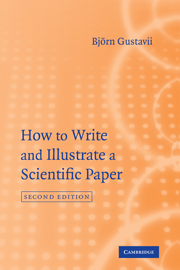Book contents
- Frontmatter
- Contents
- Preface
- Acknowledgments
- 1 Basic rules of writing
- 2 Comments on scientific language
- 3 Drafting the manuscript
- 4 Choosing a journal
- 5 Preparing a graph
- 6 Drawings
- 7 Figure legends
- 8 How to design tables
- 9 Title
- 10 Authors
- 11 Abstract
- 12 Introduction
- 13 Methods
- 14 Results
- 15 Discussion
- 16 Acknowledgments
- 17 References
- 18 Ph.D. and other doctoral theses
- 19 Letters and case reports
- 20 Numbers
- 21 Abbreviations
- 22 How to present statistical results
- 23 Typing
- 24 Dealing with editors and referees
- 25 Correcting proofs
- 26 Authors‘ responsibilities
- Literature needed on your desk
- Further reading
- Literature cited
- Index
26 - Authors‘ responsibilities
Published online by Cambridge University Press: 05 June 2012
- Frontmatter
- Contents
- Preface
- Acknowledgments
- 1 Basic rules of writing
- 2 Comments on scientific language
- 3 Drafting the manuscript
- 4 Choosing a journal
- 5 Preparing a graph
- 6 Drawings
- 7 Figure legends
- 8 How to design tables
- 9 Title
- 10 Authors
- 11 Abstract
- 12 Introduction
- 13 Methods
- 14 Results
- 15 Discussion
- 16 Acknowledgments
- 17 References
- 18 Ph.D. and other doctoral theses
- 19 Letters and case reports
- 20 Numbers
- 21 Abbreviations
- 22 How to present statistical results
- 23 Typing
- 24 Dealing with editors and referees
- 25 Correcting proofs
- 26 Authors‘ responsibilities
- Literature needed on your desk
- Further reading
- Literature cited
- Index
Summary
Subjects‘ right to privacy
How to protect a subject's identity? In this figure, executed with a dash of humor, the anonymity of both subjects has been protected by the traditional black band across the eyes.
Nevertheless, a few weeks later, in Letters to the Editor, a reader told us that despite the bar across the animal's eyes, he had immediately recognized it as one he had seen in Melbourne Zoo and suggested that authors should take greater care to preserve anonymity when presenting ape data (Millar 1982).
This observation tells us that a black band across the eyes may be insufficient to disguise the subject. So, in cases like this, informed consent should be obtained, as recommended by the International Committee of Medical Journal Editors (1995). The woman in the figure had given such consent. Simkin's figure also tells us that authors need not always be deadly serious in their reporting. Rather, humor can help to convey the message.
Duplicate submission
One of my course participants asked:
If I submit a paper to a journal, can I at the same time, in a revised form, send a paper (same subject, same material) to another journal? Or would my young research career finish there and then?
Yes, that would be the end! A unanimous jury would give you nothing less than a life sentence for self-plagiarism, as happened to an author who had submitted the same manuscript to two journals in the USA. All American journals publishing in that field agreed never again to consider any manuscript from that scientist's laboratory (Abelson 1982).
- Type
- Chapter
- Information
- How to Write and Illustrate a Scientific Paper , pp. 142 - 149Publisher: Cambridge University PressPrint publication year: 2008



